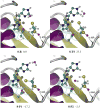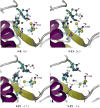Matrix metalloproteinase 2 (MMP2) inhibition: DFT and QM/MM studies of the deprotonation-initialized ring-opening reaction of the sulfoxide analogue of SB-3CT
- PMID: 20039633
- PMCID: PMC2821710
- DOI: 10.1021/jp909327y
Matrix metalloproteinase 2 (MMP2) inhibition: DFT and QM/MM studies of the deprotonation-initialized ring-opening reaction of the sulfoxide analogue of SB-3CT
Abstract
(4-Phenoxyphenylsulfonyl)methylthiirane (SB-3CT) is the selective inhibitor of matrix metalloproteinase 2 (MMP2). The inhibition mechanism of MMP2 by SB-3CT involves C-H deprotonation with concomitant opening of the three-membered heterocycle. In this study, the energetics of the deprotonation-induced ring-opening of (4-phenoxyphenylsulfinyl)methylthiirane, the sulfoxide analogue of SB-3CT, are examined computationally using DFT and QM/MM calculations. A model system, 2-(methylsulfinylmethyl)thiirane, is used to study the stereoelectronic and conformational effects of reaction barriers in methanol. For the model system in methanol solution (using the polarizable continuum model), the reaction barriers range from 17 to 23 kcal/mol with significant stereoelectronic effects. However, the lowest barriers of the (R,R) and (S,R) diastereomers are similar. Two diastereomers of the sulfoxide analogue of SB-3CT are studied in the active site of MMP2 by QM/MM methods with an accurate partial charge fitting procedure. The ring-opening reactions of these two diastereomers have similar reaction energetics. Both are exothermic from the reactant to the ring-opening product (thiolate). The protonation of the thiolate by a water molecule is endothermic in both cases. However, the deprotonation/ring-opening barriers in the MMP2 active site using QM/MM methods for the (R,R) and (S,R) inhibitions are quite different (23.3 and 28.5 kcal/mol, respectively). The TSs identified in QM/MM calculations were confirmed by vibrational frequency analysis and following the reaction path. The (R,R) diastereomer has a hydrogen bond between the sulfoxide oxygen and the backbone NH of Leu191, while the (S,R) has a hydrogen bond between the sulfoxide oxygen and a water molecule. The dissimilar strengths of these hydrogen bonds as well as minor differences in the TS structures contribute to the difference between the barriers. Compared to SB-3CT, both diastereomers of the sulfoxide analogue have higher reaction barriers and have less exothermic reaction energies. This agrees well with the experiments, where SB-3CT is a more effective inhibitor of MMP2 than its sulfoxide analogue.
Figures







Similar articles
-
QM/MM Studies of the Matrix Metalloproteinase 2 (MMP2) Inhibition Mechanism of (S)-SB-3CT and its Oxirane Analogue.J Chem Theory Comput. 2010 Nov 9;6(11):3580-3587. doi: 10.1021/ct100382k. J Chem Theory Comput. 2010. PMID: 21076643 Free PMC article.
-
DFT studies of the ring-opening mechanism of SB-3CT, a potent inhibitor of matrix metalloproteinase 2.Org Lett. 2009 Jun 18;11(12):2559-62. doi: 10.1021/ol9008393. Org Lett. 2009. PMID: 19445474 Free PMC article.
-
Matrix metalloproteinase 2 inhibition: combined quantum mechanics and molecular mechanics studies of the inhibition mechanism of (4-phenoxyphenylsulfonyl)methylthiirane and its oxirane analogue.Biochemistry. 2009 Oct 20;48(41):9839-47. doi: 10.1021/bi901118r. Biochemistry. 2009. PMID: 19754151 Free PMC article.
-
Active site ring-opening of a thiirane moiety and picomolar inhibition of gelatinases.Chem Biol Drug Des. 2009 Dec;74(6):527-34. doi: 10.1111/j.1747-0285.2009.00881.x. Epub 2009 Oct 6. Chem Biol Drug Des. 2009. PMID: 19807733 Free PMC article.
-
Small-molecule MMP2/MMP9 inhibitor SB-3CT modulates tumor immune surveillance by regulating PD-L1.Genome Med. 2020 Sep 28;12(1):83. doi: 10.1186/s13073-020-00780-z. Genome Med. 2020. PMID: 32988398 Free PMC article.
Cited by
-
QM/MM Studies of the Matrix Metalloproteinase 2 (MMP2) Inhibition Mechanism of (S)-SB-3CT and its Oxirane Analogue.J Chem Theory Comput. 2010 Nov 9;6(11):3580-3587. doi: 10.1021/ct100382k. J Chem Theory Comput. 2010. PMID: 21076643 Free PMC article.
-
Metal-ion promiscuity of microbial enzyme DapE at its second metal-binding site.J Biol Inorg Chem. 2021 Aug;26(5):569-582. doi: 10.1007/s00775-021-01875-7. Epub 2021 Jul 9. J Biol Inorg Chem. 2021. PMID: 34241683
-
O-phenyl carbamate and phenyl urea thiiranes as selective matrix metalloproteinase-2 inhibitors that cross the blood-brain barrier.J Med Chem. 2013 Oct 24;56(20):8139-50. doi: 10.1021/jm401217d. Epub 2013 Oct 8. J Med Chem. 2013. PMID: 24028490 Free PMC article.
-
Mechanisms of Proteolytic Enzymes and Their Inhibition in QM/MM Studies.Int J Mol Sci. 2021 Mar 22;22(6):3232. doi: 10.3390/ijms22063232. Int J Mol Sci. 2021. PMID: 33810118 Free PMC article. Review.
-
Sulfonate-containing thiiranes as selective gelatinase inhibitors.ACS Med Chem Lett. 2010 Dec 13;2(2):177-81. doi: 10.1021/ml100254e. eCollection 2011 Feb 10. ACS Med Chem Lett. 2010. PMID: 24900296 Free PMC article.
References
Publication types
MeSH terms
Substances
Grants and funding
LinkOut - more resources
Full Text Sources
Miscellaneous

